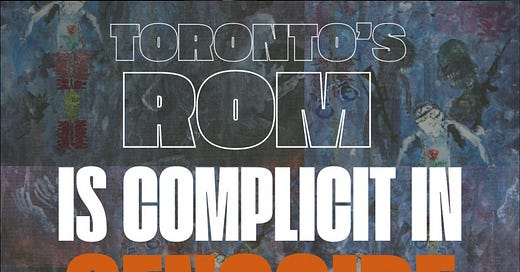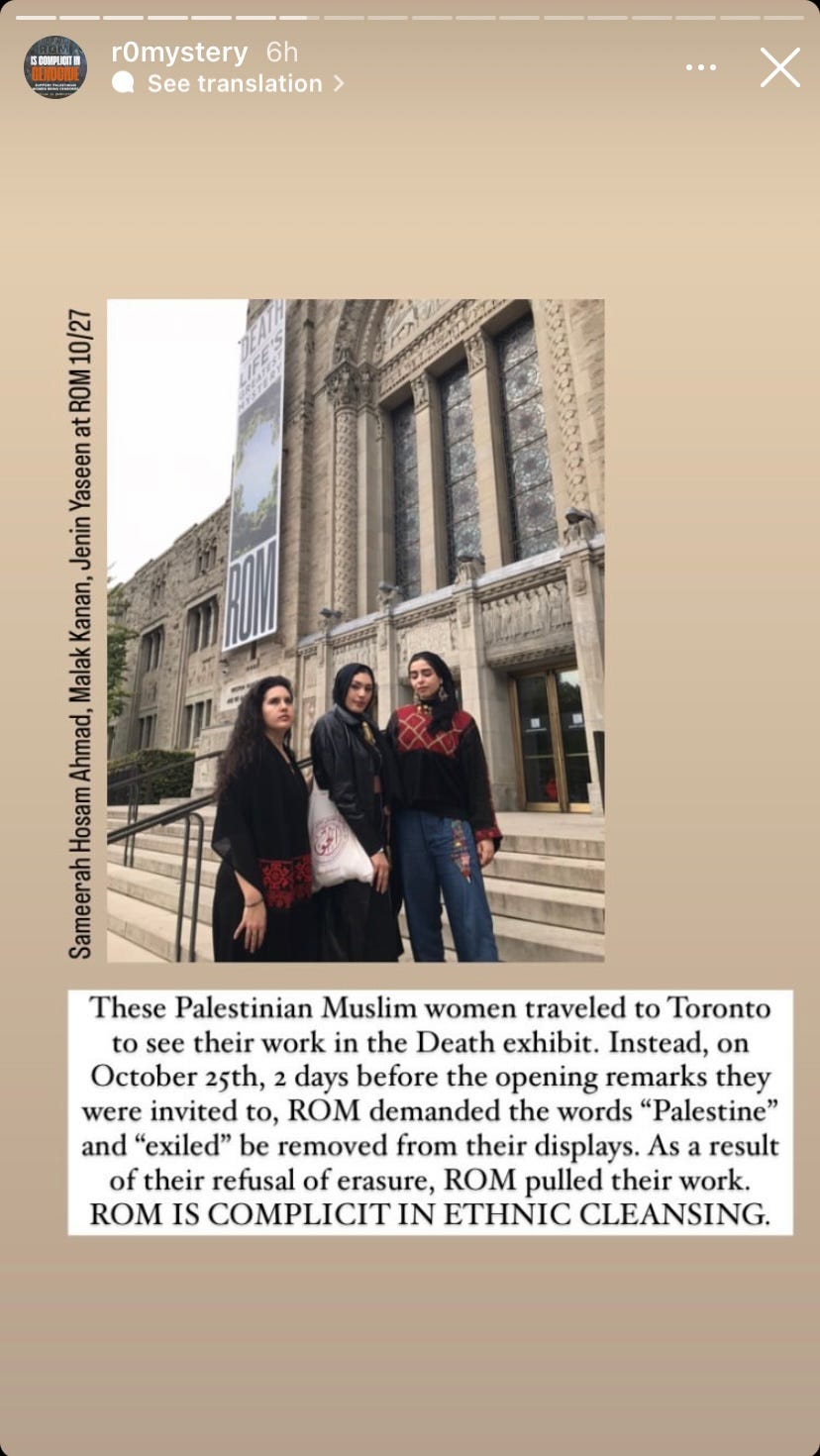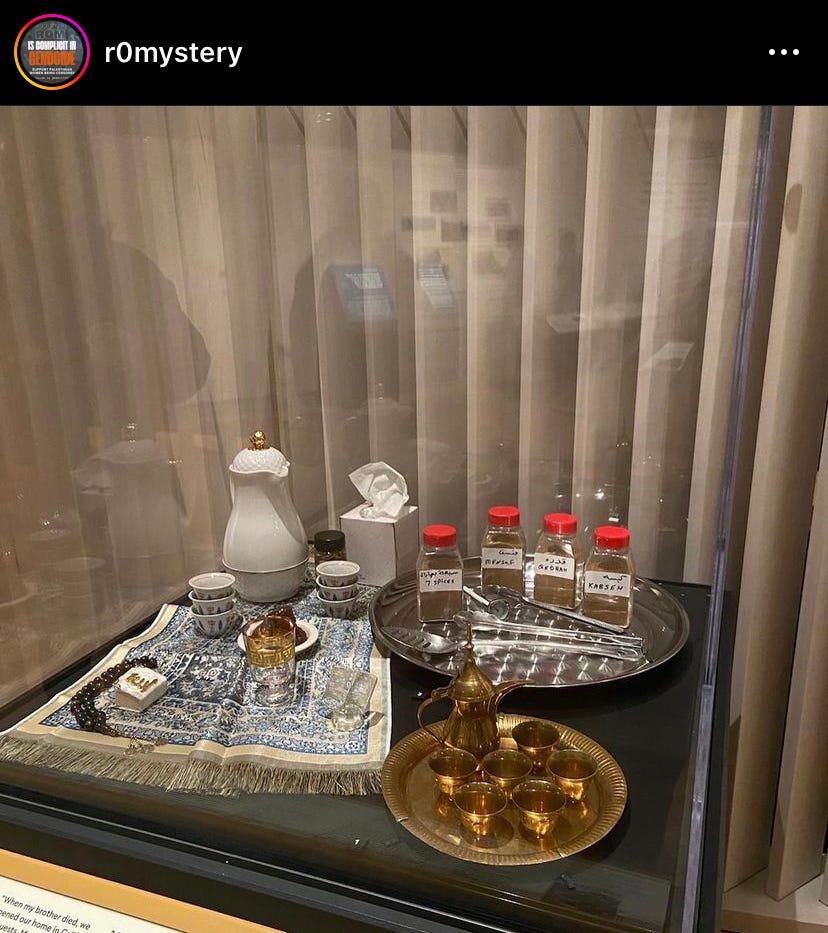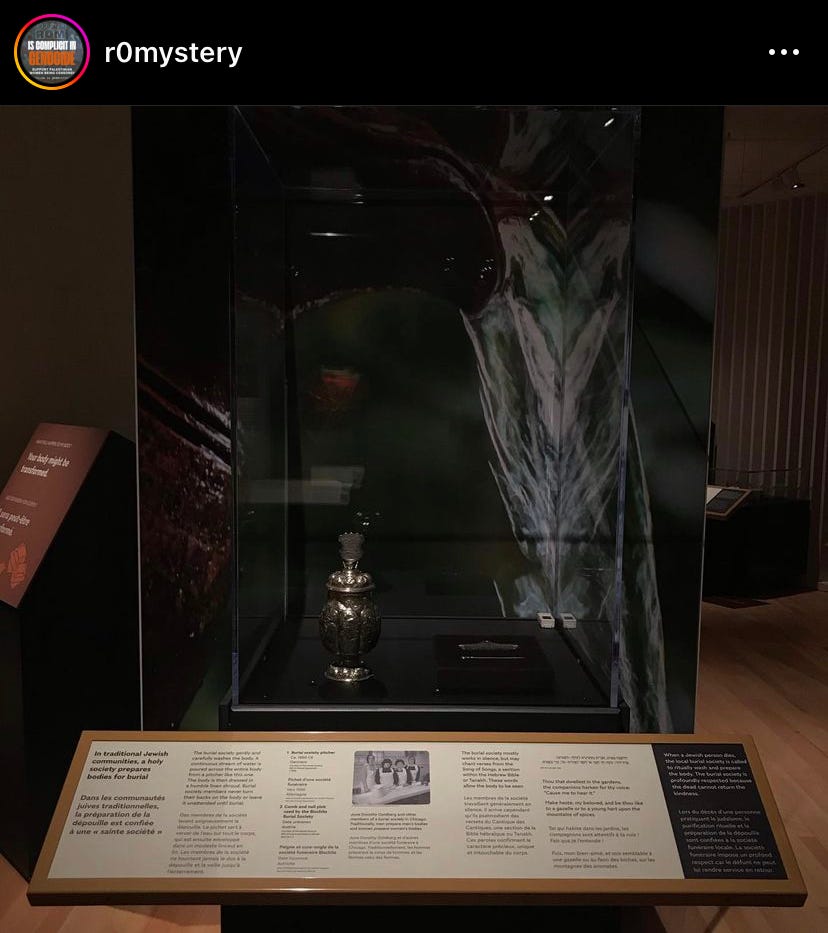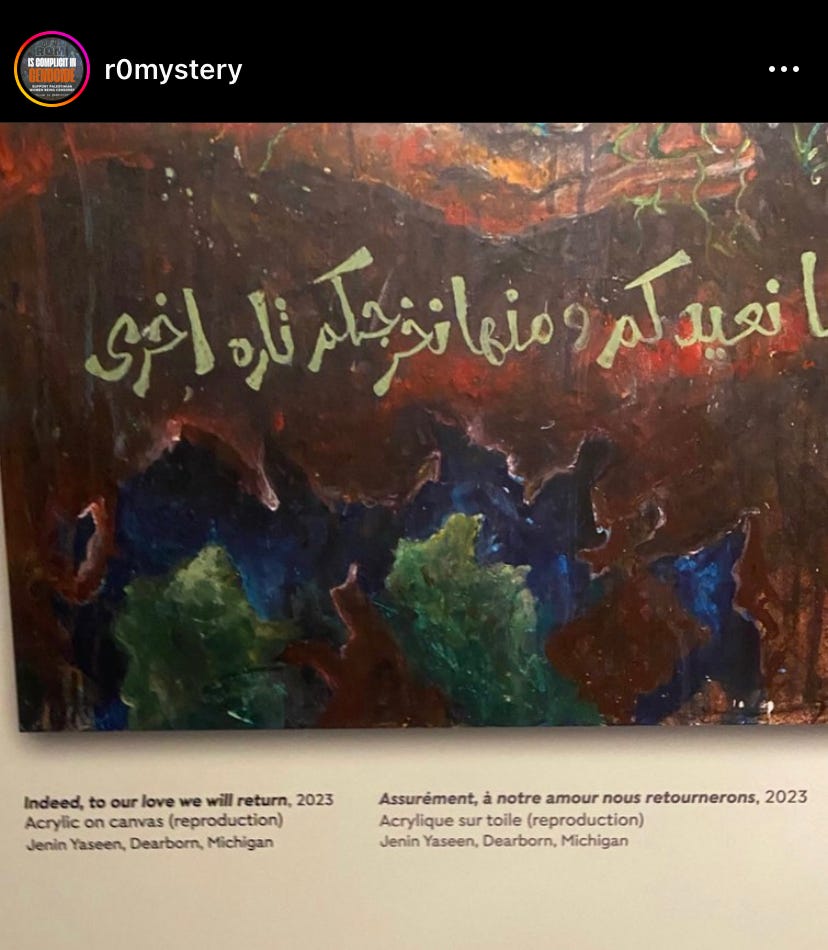The ROM Censors Palestinian Death and Grief
A timeline of the Palestinian women-led movement to stop The Royal Ontario Museum's anti-Palestinian censorship
FIRST AND FOREMOST:
CEASEFIRE NOW!
In Volume 25 we were honored to share our third installment of Falasteen Focus by Sameerah, a dear friend of the Digest. Falasteen Focus “features a handful of offerings on Palestinian death, grief, life, love, and culture.” In this installment, Sameerah highlighted their family and communities’ contribution to Death: Life’s Greatest Mystery, a traveling exhibition which opened at the Royal Ontario Museum (ROM) on October 28. From Falasteen Focus:
The Field Museum in Chicago created a traveling exhibition called Death: Life’s Greatest Mystery in which participants are challenged to “Consider your own “big questions” about death as you explore natural and cultural responses to life’s inevitable conclusion.” The exhibition includes two displays about Palestinian death and grief practices.
One display is titled "Muslims have practiced green burial for centuries" and features a painting by Dearborn-based Palestinian artist Jenin Yaseen, commissioned especially for the Death exhibition, as well as a green burial crosshatch drawing by Landis Blair that was featured in Caitlin Doughty's From Here to Eternity…
The second Palestinian display in the Death exhibition is titled "In Palestinian Muslim communities, grieving families serve and are served" and focuses on the beit azza tradition. After the janazah (prayer service) and dafan (burial), the immediate family opens their home for three days. During this beit azza (house of condolences) guests are served qahwa saada (black coffee with cardamom) and dates. The display features household items from the families of Dina Omar and Malak Kanan, along with a moving story from Dina’s personal experience hosting a beit azza.
Next to the household items sits a tray with my father's cooking tools and spices. Chef Hosam works at Aladdin Pita restaurant in Indiana. One Friday at 6:35 AM he received a call that a young man from his village (Turmusayya) had died, and would be buried that same day in accordance with Islamic tradition. By 5 PM, he prepared eleven large platters of roasted lamb with kabseh rice, to be served at a community center in Chicago. This is when I realized Baba is a death worker, too. Over the years he has been on call to serve dozens of funerals and, no matter the time or day, he will pour his heart and soul into his cooking in honor of the community member who died as well as their grieving family.
Sameerah informed us that prior to the exhibit’s opening, the ROM censored not only these two displays but also the display relating to Jewish death and grief rituals by removing important context and history related to the pieces.
From @ r0mystery instagram, which was created to document this injustice:
“The ROM removed the word "Palestine" from the exhibition as well as other texts and images relating to Palestine including symbolism of a martyr wearing a keffiyeh. The exhibition was intended to highlight diverse death rituals. Through this censorship the ROM is complicit in the dehumanization of Palestinians in both life and death.” [post]
“ROM leadership told us because our Palestinian Muslim displays couldn’t be shown, the Jewish display would be removed “in principle.” This is an absurd and warped attempt to make Palestinian erasure seem fair. This is NOT fair. This is disturbing. The ROM MUST restore the Jewish display case to the full treatment, grace, and honor it received at the Field Museum in Chicago. The ROM must cease its dehumanization of both Muslims and Jews in its curation of Death: Life’s Greatest Mystery.” [post]
On October 28, Sameerah and Jenin staged an 18-hour sit in at the ROM.

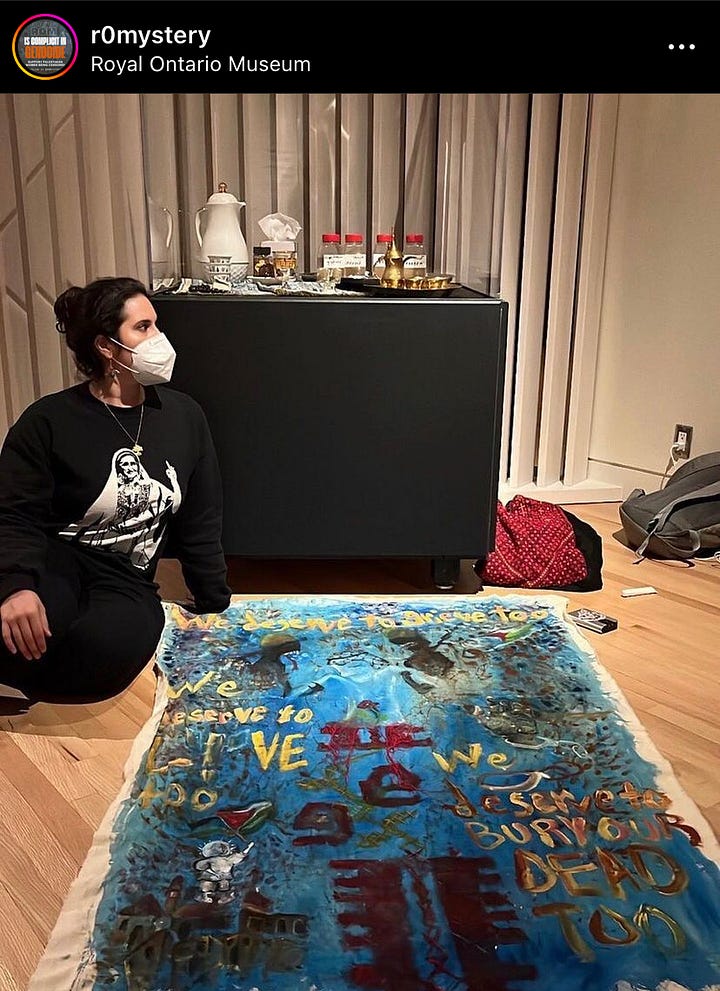
Their demands were simple:
Restore the original text panel for the Beit Azza display as shown at the Field Museum.
Restore the original text panel for the Jewish display as shown at the
Field Museum.Restore the original Green Burial panel that includes Jenin Yaseen’s full painting as shown at the Field Museum.
Apologize to the 4 Palestinian women the ROM harmed. "ROM apologizes for the disrespect you felt. We acknowledge our failure to understand your perspectives, which caused you pain and frustration at a time of great difficulty."
Ensure this censorship doesn’t happen to other Palestinian artists and community members working with the ROM.
Revoke the problematic one-sided statement that failed to acknowledge Palestinian lives. "In addition, in our public statements about the Israel-Hamas conflict, ROM will more clearly share our belief in the universal value of all lives and our recognition of the immense suffering resulting from the ongoing conflict."
The ROM only agreed to meet the first three demands, promising the restoration of the original text and panels would go into effect on Tuesday, October 31. As of November 1, the exhibit remained closed.
Sameerah’s father, Chef Hosam, who’s cooking tools and spices were included in one of the censored exhibits, drove to Canada to personally express his frustration with the ROM’s decision to censor and close the exhibit.
“Chef Hosam Ahmad drove overnight from Indiana to see his work in the Death exhibition at the ROM this morning. As a condition of ending the recent 18-hour sit-in, ROM agreed to reopen the gallery on October 31 with the uncensored Muslim and Jewish displays fully intact. ROM reneged on that promise. Chef Hosam shares his frustration, especially after the Death exhibition was such a positive experience for him in Chicago. The ROM must reopen the Death gallery tomorrow morning, November 1, so that Chef Hosam and the Toronto community can see the display he worked on which honors Palestinian mourning practices. He should be grieving the loss of over 8,000 Palestinians in Gaza with his community, not proving his humanity to an institution engaged in anti-Palestinian censorship.” [post]
This continued closure impacted all of the other artists who’s works are included in the exhibit. On Día de los Muertos, artist Norma Rios Sierra’s family ofrenda was unable to be visited and honored:
“Norma Rios Sierra should be celebrating Día de Muertos today instead of fighting for her work to be shown at the ROM. This ofrenda she built sits behind locked doors because the ROM is shamefully stalling the Death exhibition’s re-opening after censoring Palestinian storytellers. Norma writes, “The ROM should reopen the Death exhibit and stop prohibiting the public from viewing our stories. Everyone deserves a space to share their perspectives and museums should be the neutral ground to do that in. Censoring artists just goes in line with what museums have always done by robbing us of the opportunity to share our stories on our own terms. Museums are used to dealing with stolen artifacts and not living breathing human beings.” [post]
On November 2, their movement honored the sacred practice of grieving and stood in solidarity with Norma Rios Sierra by creating a public altar on the steps of the ROM.
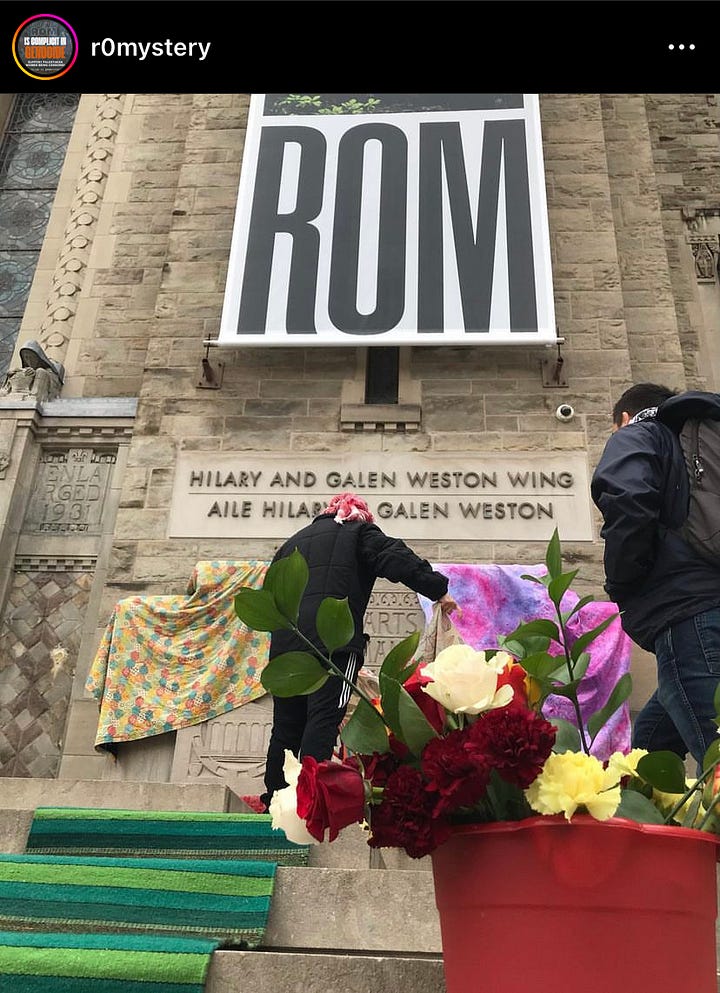
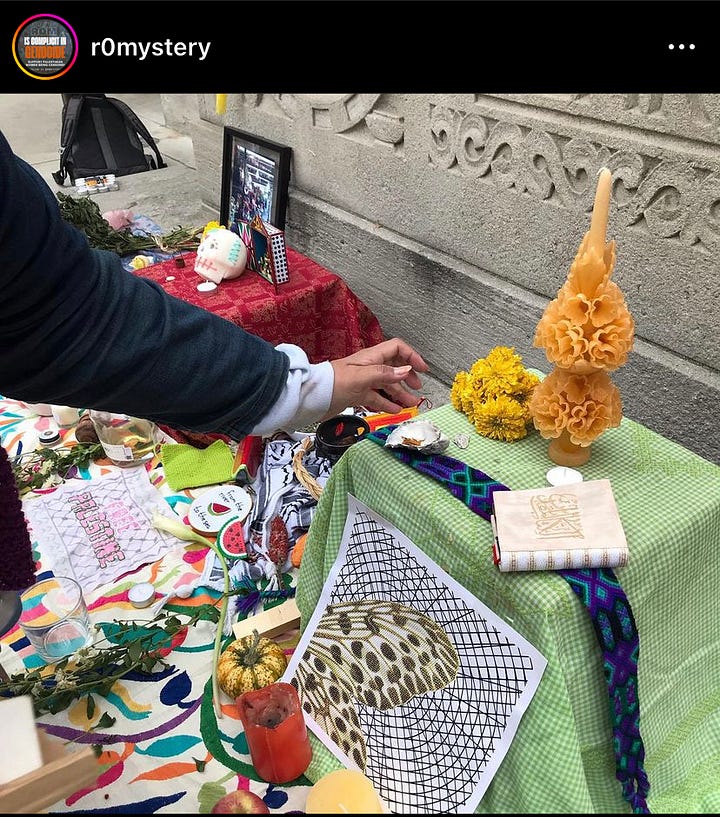
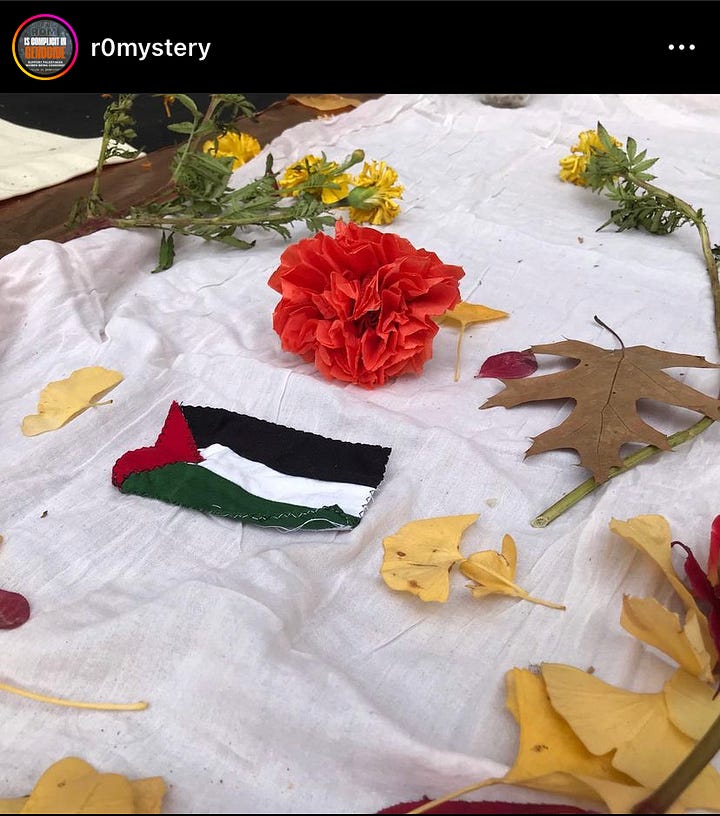
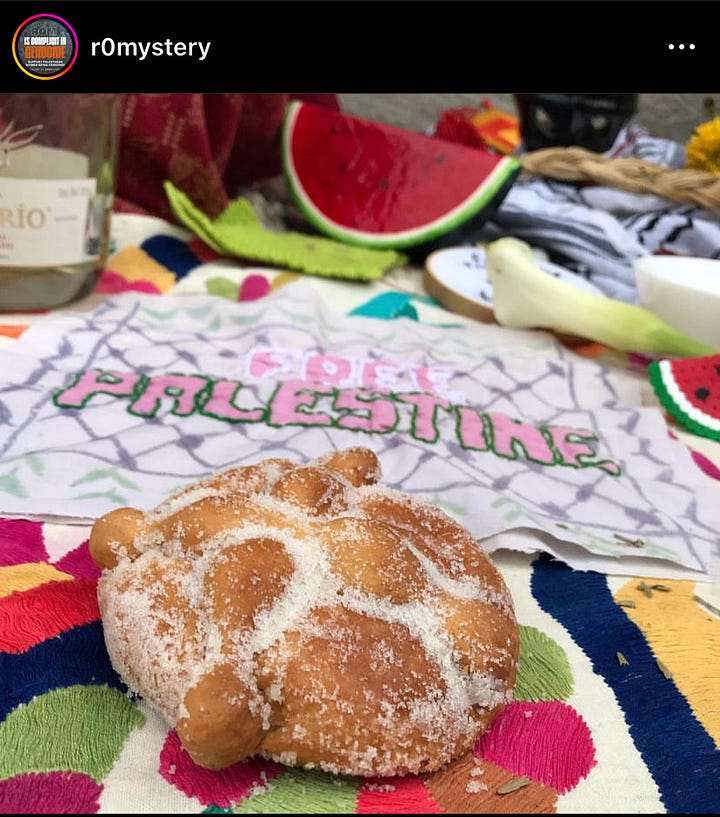
On Friday, November 3, the 10th day of their protest, the ROM finally reopened Death: Life’s Greatest Mystery with the displays returned to their original form. However, upon closer inspection of the displays, it became clear that the ROM still intended to distance themselves from the work by adding caveats and censorship warnings next to the displays focused on Palestinian death and grieving (and only the Palestinian displays). To add insult to injury there were many grievous errors throughout the restored text accompanying the Palestinian and Jewish displays, both in English and in French. Names were misspelled and incorrectly attributed, text was missing, incorrect translations were added.
“The ROM continues to engage in anti-Palestinian censorship and neglected to treat our displays and stories with the care and intention they deserve. Because they re-designed so many things, instead of just showing our displays as they were shown at the Field Museum, there are numerous examples of incorrect labeling, mis-attributed quotes, name misspellings, and a significant discrepancy in the way the English was translated into French, which completely changes the original words and meaning. The ROM also added a notice next to the beit azza display, and added a notice and a discriminatory content warning to the green burial display which gives a physical cue to stop before entering the gallery section the display is cornered into. They didn’t just post this on the wall, they installed a free standing structure that inhibits museum-goers from freely approaching the work without any barriers. The last Palestinian woman storyteller is now heading home. None of the Palestinian women nor Chef Hosam were able to see their work in Toronto as it was originally shown in the Field Museum.” [post]
As we witness a nationalist regime trap and slaughter thousands of children, women, men, elders, human beings, we are outraged at The Royal Ontario Museum’s fear and disregard of Muslim and Jewish death and grief practices. We urge the ROM to meet the r0mystery collective’s complete demands and to cease acquiescing to Zionist funders.

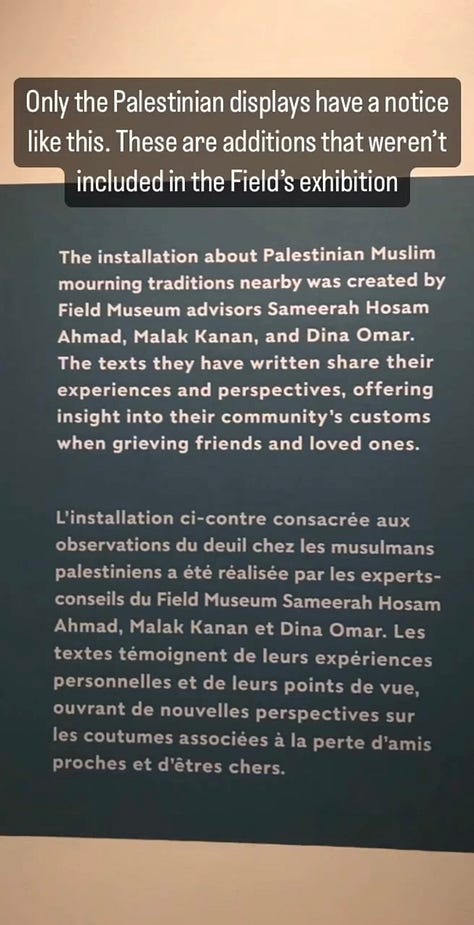
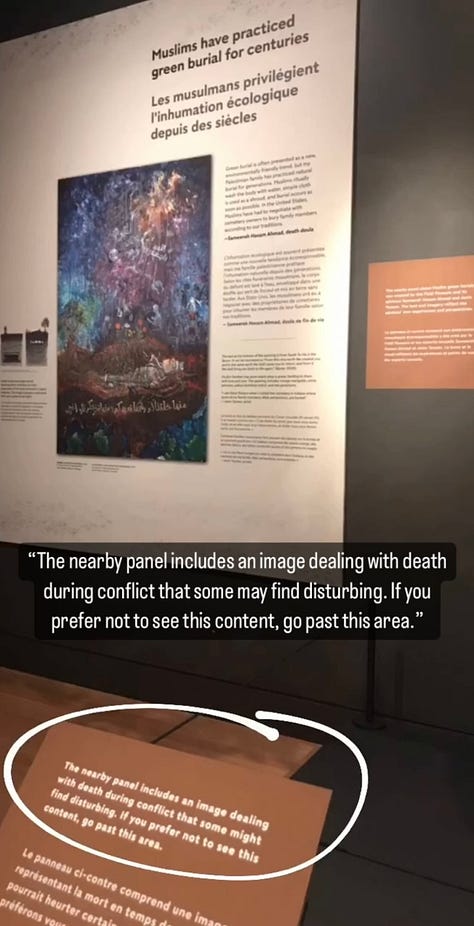
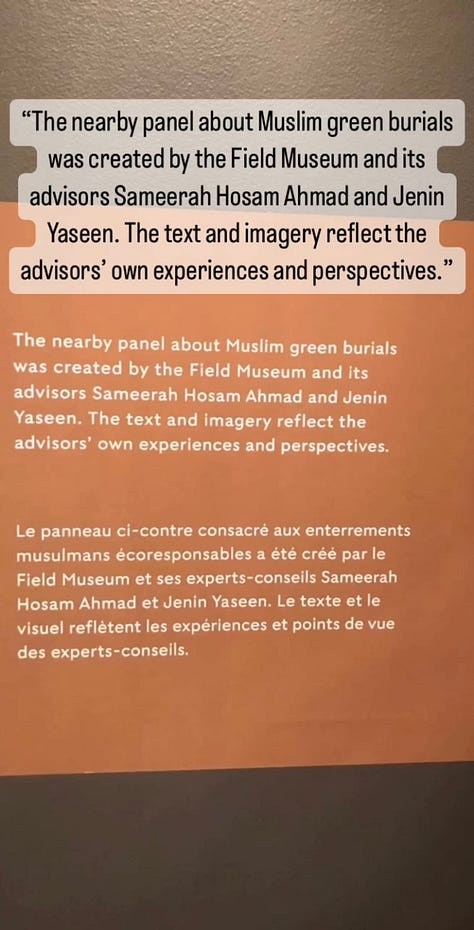
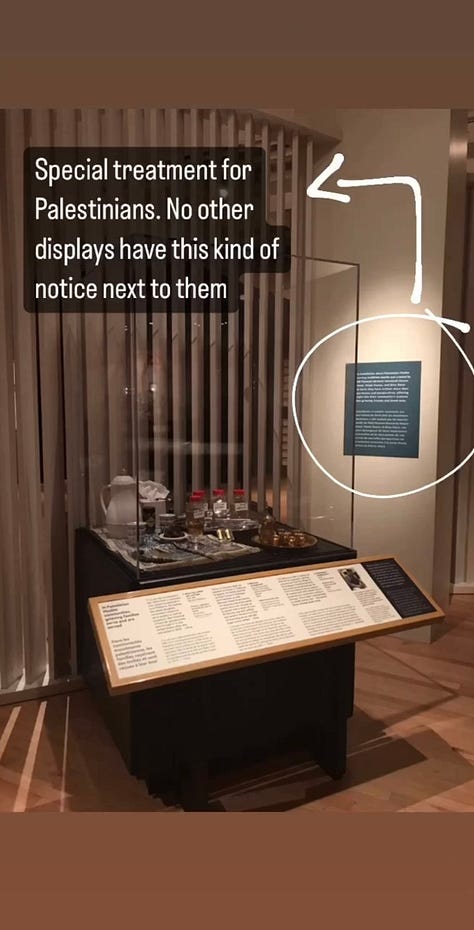
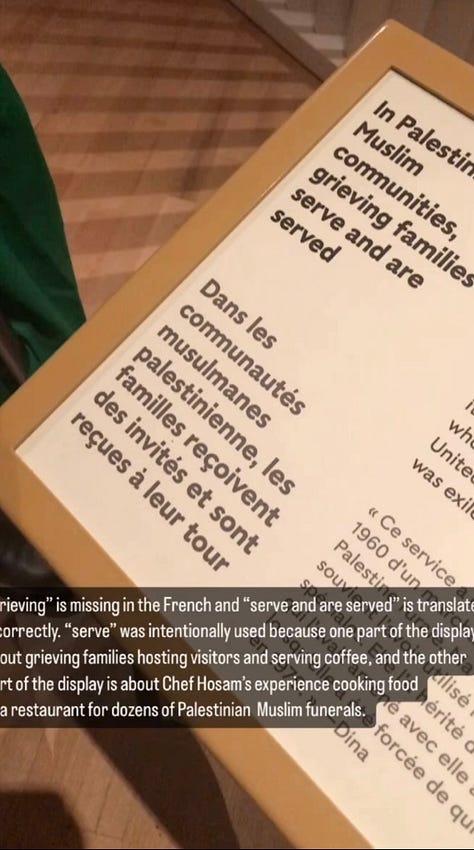
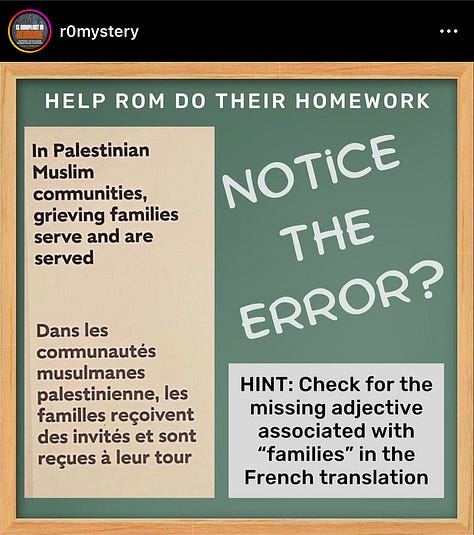
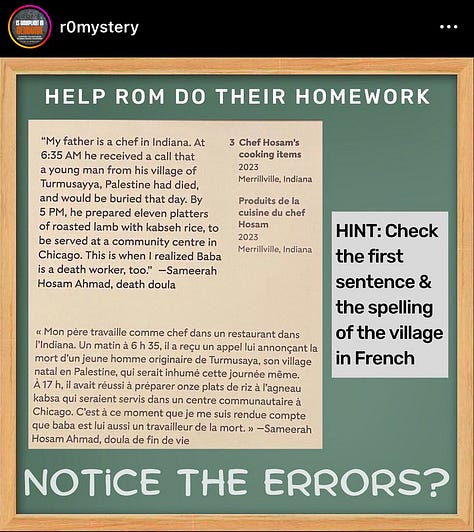
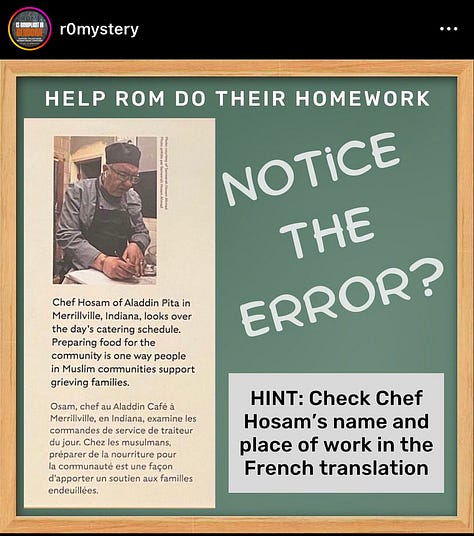

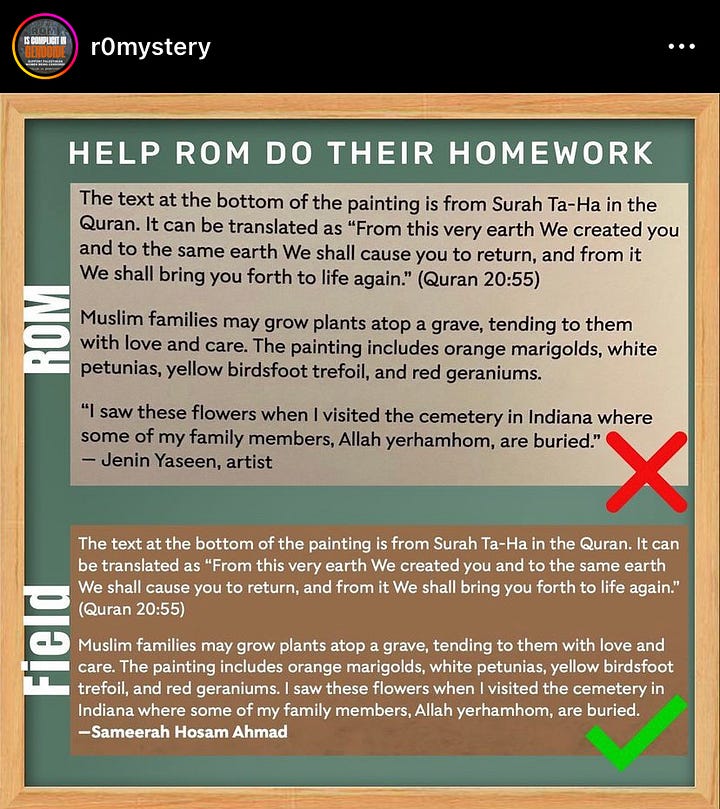
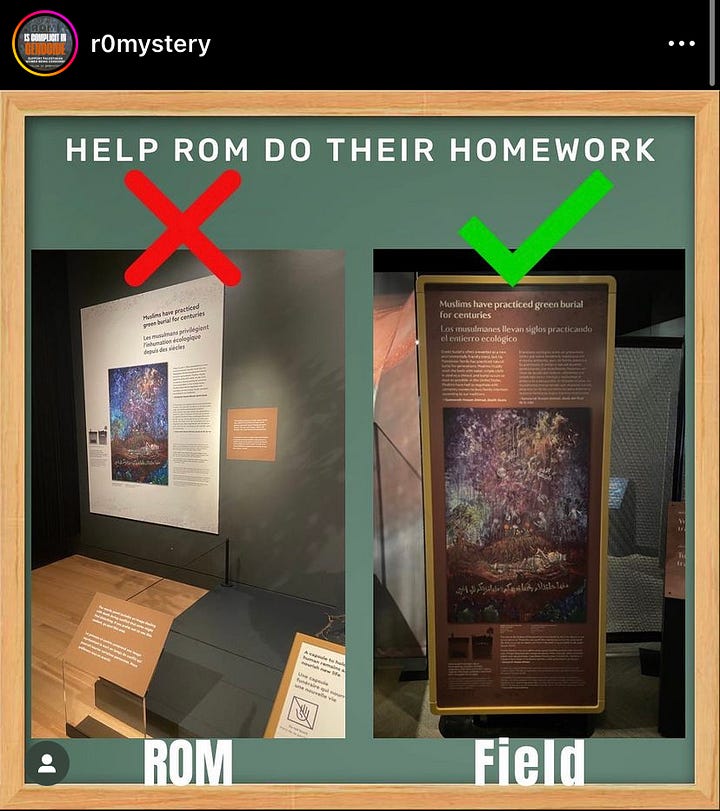
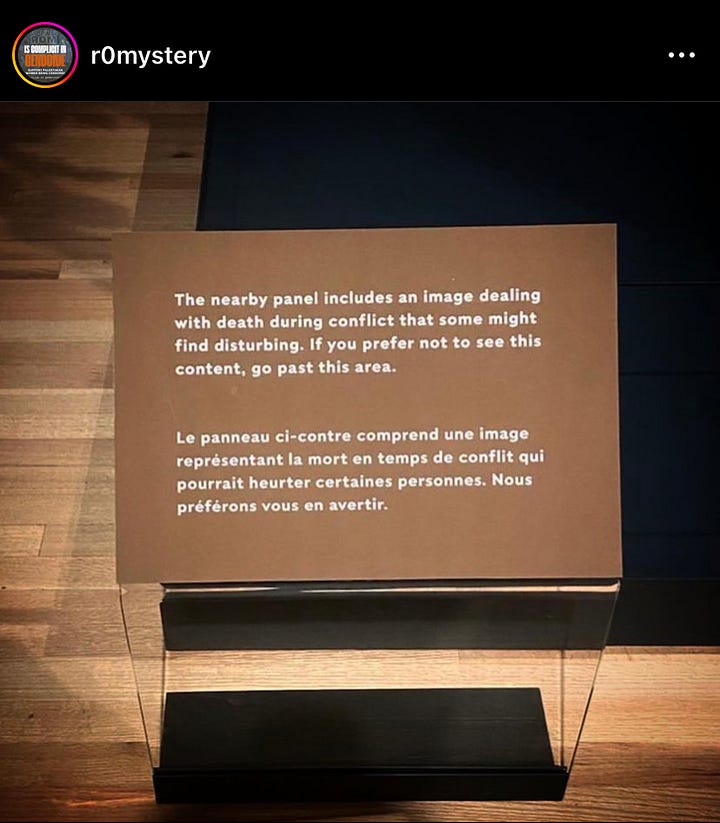
“ROM’s inaccuracies are so prolific it almost seems intentional, if not just rampant negligence. Here the correct English reads “grieving families” but the French translation is missing the word for grieving. Also, the translation for “serve and are served” is incorrect. The storytellers intentionally used the word “serve” because one part of the display case features beit azza items that would be used in the home of the grieving family (including serving coffee to guests), and the other part of the display case features Chef Hosam’s cooking tools which would be used in the restaurant. Swipe over to the next photo to see the items in the display case. The display case and accompanying text panel were supposed to be seen by Toronto on Oct 27. Because of anti-Palestinian censorship, this display case was shown WITHOUT a text panel on Oct 27 and 28. The exhibition then closed until Nov 3 which is when we saw these errors. The ROM kept altering and re-designing our displays (at one point they put a censorship notice within the text of this panel, they removed the word “Palestine,” etc) because of their censorship. If ROM showed the displays as they were originally shown at the Field Museum, all of this could have been avoided.” [post]
“The Jewish display in ROM’s version of the Death: Life’s Greatest Mystery exhibition includes a major error. The original display text as shown by the Field Museum is below. ROM’s text is above and is missing the words “as precious, unique, and protected.” Interesting, the French translation retained the correct wording. Why such an error? — The ROM kept altering, manipulating, and re-designing the Jewish and Muslim days because of anti-Palestinian censorship. On Oct 25 they told Palestinian women storytellers that because the Muslim displays included the words “Palestine” and “exiled” the ROM needed to censor them, and that “in principle” they would censor the Jewish display as well. This is absurd and racist. Swipe over to the next photo to see the entire Jewish display, which was created by the Field Museum and its community advisors. When Palestinian women storytellers attended the ROM’s members-only preview of the Death gallery on Oct 27, their Muslim green burial display was missing altogether, nowhere to be found. Additionally, the other Muslim display’s text panel and the Jewish display’s text panel had both been removed. ROM members were unable to experience Muslim and Jewish stories as they looked puzzlingly at the sacred items within the wordless display cases. When ROM opened the gallery to the public on Oct 28, they too were unable to experience Muslim and Jewish death practices and mourning rituals. This is disgustingly inappropriate, inaccessible, and unacceptable. All because the ROM refuses to cease its anti-Palestinian censorship and complicity in genocide. ROM then shuttered the gallery and didn’t reopen it until Nov 3 (even though the 18-hour sit-in was called off because ROM committed to reopening the gallery on Oct 31 with unaltered Muslim and Jewish displays) which is when Palestinian women storytellers noticed the errors and alterations within the Muslim and Jewish displays. To this day the errors remain.” [post]
“ROM’s altered version of the Muslim green burial display includes a major error. Sameerah’s quote starting with, “Muslim families may grow plants atop a grave…,” has been split into 2 parts. The first part in ROM’s altered green burial display graphic appears to be “museum voice” and the second part is attributed to the other Palestinian woman who contributed to the display and created the painting. Additionally, if you swipe over to the next image you will see that the ROM has added “(reproduction)” next to the painting description, which was NOT on the Field Museum display. On Oct 25 ROM leadership tried to argue they can literally blur out part of the painting, and place a quote over it, because “it’s a reproduction”. The Field representative in the meeting stated plainly that the Field doesn’t consider it a reproduction that can be altered. Furthermore, at ROM’s members-only preview of the Death exhibition on Oct 27, the painter asked ROM Curator Chen Shen, “Where’s my painting?” after which he looked at her smugly and said “What painting?” and paused, and then said “it’s a reproduction.” When Palestinian women storytellers attended the members-only preview that day, the Muslim green burial display was missing altogether, nowhere to be found...” [sic] [post]

